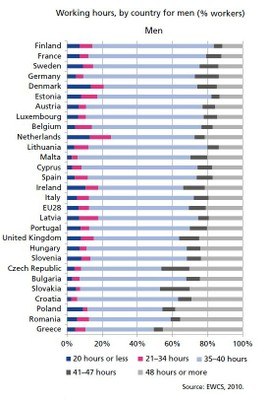Whether a person is in employment or not can be a tricky enough question, as working life becomes increasingly flexible — or uncertain — depending on whether you are an employer or employee.
But the grey areas of uncertainty become even greater if you look at work environments. Anything from nano particles, chemicals, noise and working hours to salaries and management issues can influence work environments. Conditions which one person can handle just fine could be the very things making another person sick. As the service industry grows, the kind of work environment issues which matter the most changes too.
It is not so easy to determine whether or not a business is ‘healthy’ either. Is the level of sick leave falling because the work environment has improved or is it because those who are on sick leave are taking early retirement?
For as long as the two European work environment organisations have existed, a lot has been done to gather comparable statistics. The first pan-European survey, called the European Working Conditions Survey — or EWCS — was not carried out until 1991, and included 12 member states. The latest one, EWCS 5, came in 2010 and included 34 countries, including Norway (but not Iceland). 44,000 people were interviewed and asked to answer 242 questions. Work is still going on to analyse the material and to draw conclusions.
Changing theories
While the surveys have been carried out, the view of for instance psychosocial risks has changed too. Researchers have launched different theories for what causes the problems. This means new questions must be asked.
The joint report, ‘Psychosocial risks in Europe: Prevalence and strategies for prevention’, lists three influential theoretical concepts:
- The first is the demand and control theory, developed 35 years ago by Swedish researcher Töres Theorell and his American colleague Robert A Karasek. According to the two professors, jobs with high levels of demand coupled with low levels of control lead to negative health effects and poor production levels. People’s creativity and enthusiasm should be encouraged instead.
- The second theory proposes that psychological stress results from a mismatch between efforts made by workers and the rewards they receive from their employer in terms of pay, esteem, job security and career opportunities. The Swiss researcher Johannes Siegrest is behind this model which is known as the effort-reward imbalance model.
- The third theory looks at how work is organised and whether the workload is distributed equally. ‘Organisational justice’ is an umbrella term for many different kinds of justice issues, looking at whether men and women get equal pay for equal work, whether workers’ input is measured in a way they have no confidence in, unfair dismissal etc. The Finnish researcher Marjko Evolaino is one of those who have shown how these issues have major consequences for people’s health too.
More training needed
One statistic built on the first theory looks at whether employees possess the necessary skills to solve the tasks they are given. 13 percent of workers in the EU say they need more training in order to manage their jobs. The size of the problem depends on your trade. Only seven percent of farmers feel they need more training, while 20 percent of people working in finance feel they do.
The technological development is an important factor. 48 percent of Nordic workers said processes and technology had changed in their workplace in the past three years — a number which is higher than the EU average. In Sweden a full 58 percent answered yes to this question.
Despite the rapid development, monotonous work mixed with high work intensity represents the biggest work environment problem in Europe. Nearly half of all workers in Europe are facing such risks. Finland is top among the Nordic nations when it comes to how many workers face monotonous working tasks, and the level is above the European average.
Finland best for working hours
Working hours represent another well-known problem. European employees work three hours less per week on average compared to 20 years ago, but one third of them work unusual hours and 20 percent work a lot of overtime. Out of all the European countries, Finland has the most ‘normal’ working hours. Men work around 35-40 hours a week, while some women work slightly less normal hours (either more or less than 35-40 hours a week).

When trying to draw conclusions for how psychosocial and other work environment problems can be solved, you must also consider national surveys. But it is often difficult to get the message across that you not only need more jobs, but better jobs.
“There is a considerable gap between labour market research (usually carried out by economists) and social research (usually carried out by sociologists). The former is based too much on quantitative data, while the latter is more open to use a broader selection of data, including subjective and qualitative surveys,” the report’s authors note.





